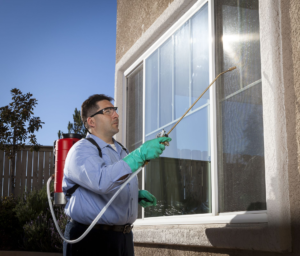The venom from these spiders contains neurotoxins that can cause pain, muscle cramping, sweating, and heart palpitations. They inject their poison with fang-like apparatuses called chelicerae.
Though many people fear these spiders, they rarely bite people unless they are provoked or their web is disturbed. Only one person has died from a black widow bite. Click the Poisonous Spiders In Kentucky to learn more.

The black widow is a very dangerous spider with a wide geographic distribution. It eats insects and is particularly fond of consuming flies and other house-dwelling pests. Female black widow spiders are named after their distinctive red hourglass-shaped mark on the underside of their abdomen.
The most common species of this spider, Latrodectus mactans, is glossy black in color, although some specimens can appear to be dark purple or brown. They have an elongated body with large palps extending from the first segment. The male western black widow is much smaller than the female, and has an orange or yellow hourglass mark on its underside, instead of the classic red color.
When a person is bitten by a black widow, the bite usually feels like a pin prick. The neurotoxic venom causes chest pain or tightness, abdominal cramps and nausea. Eventually, the pain will spread from the bite area to the entire body. Other symptoms include a target-shaped sore, fever, headache and sweating. Bites rarely result in death, but they are very dangerous for children, the elderly and people with weakened immune systems.
People who are bitten by a black widow should call a doctor immediately. While waiting for an ambulance or to be seen by a doctor, they should clean the bite with soap and water, apply ice packs to the affected area and take over-the-counter pain relievers. The patient should also try to put the spider or any remnants of it into a secure container and bring it with them to the hospital.
A bite from a black widow is considered a medical emergency because it can cause serious complications, including seizures and heart problems. Those who suspect they may have been bitten by a black widow should call the national poison control center at 1-800-222-1222. This is a free and confidential service that operates 24 hours a day. The doctor will likely give the victim a shot of antivenin, which contains antibodies that counteract the effects of the spider’s venom. They will probably also give the victim narcotic pain relievers and medications to lower high blood pressure.
Brown Recluse
The Brown Recluse (Loxosceles rufescens) is native to the Midwest and Southeast. It’s well-adapted to living alongside humans, finding shelter in attics and crawl spaces, cellars, wood piles, and cluttered storage areas.
It doesn’t build webs as other spiders do — instead it seeks out dry, dark areas to hide in. Brown recluses are also well-adapted to hibernating during the winter months in unheated basements and attics. They get inside homes by entering crevices around doors, vents, and soffits, or by hitching rides on boxes, furniture and clothing that people bring in from outside.
Bites from brown recluses are rare; however, they can be severe when they do occur. The initial bite is often painless, and the victim may not even know that he or she has been bitten until 3 to 8 hours later, when the area becomes red, swollen, tender, and painful. The bite often develops into a necrotic lesion, which looks like a deep bruise or a blackish-purple, ring-shaped blister. This wound is then broken down, revealing dead tissue underneath, and can cause serious medical complications if it’s not treated promptly.
A person who has been bitten by a brown recluse should immediately seek emergency treatment or visit an urgent care center. It’s important that the patient follow the RICE protocol, which includes resting, icing, compressing and elevating the bitten leg or arm. This can reduce swelling, and prevent the occurrence of an open sore or ulcer that could take months to heal.
In most cases, a doctor will inject a person with antivenin to help counteract the effects of the spider’s venom. He or she will also recommend using an antibiotic to prevent infection and treat any symptoms of an underlying illness.
Preventative measures for the brown recluse include wearing long sleeves and gloves when sorting through old materials such as boxes in the attic, and keeping cluttered areas clean. It’s also a good idea to place flat glue traps (similar to the type used for mice and cockroaches) in rooms where spiders are commonly found, such as along baseboards and on walls near corners. A professional pest control company can offer additional methods of controlling brown recluses, including targeted space treatments to eliminate the spiders that are hiding inside voids.
Funnel-Web Spider
Funnel-web spiders (Hadronyche) are one of the deadliest spiders in the world and can cause severe envenomation in humans. They are found throughout Australia and can hide in dark sheltered places, like under rocks or in cracks of houses. They build tubular webs which have a funnel-shaped retreat on one side. When they sense vibrations of prey passing over the web, they wait inside their funnel retreat to capture it. The venom of these spiders causes extreme pain, breathing problems and convulsions. If left untreated, it can lead to death within hours. Scientists have long wondered why the venom of this Australian spider is so lethal to humans, who are not the spiders’ natural predators. The answer has finally been uncovered by researchers at the University of Queensland, led by Associate Professor Bryan Fry. Using molecular analysis, the team identified 22 novel delta-hexatoxins in the venom of funnel-web spiders, which were previously unknown to science. These toxins exert fatal neurotoxic effects in humans by keeping nerves turned on, causing them to fire repeatedly.
The team also discovered that the venom of male Sydney funnel-web spiders contains a potent neurotoxin called atracotoxin, which is up to five times more toxic than that of females. This toxin attacks the nervous system and can cause a number of symptoms, including muscle twitching, sweating, vomiting, confusion, high blood pressure, metabolic acidosis, dilated pupils and pulmonary edema. In humans, these symptoms are often accompanied by difficulty breathing and coma.
In all 13 cases where the sex of a biting spider could be determined, it was found to be a male. The venom of this spider is so dangerous that it has killed at least two people in recent years, despite the availability of anti-venom.
The bite of a funnel-web spider is extremely painful, and it may feel like a snakebite. If bitten, patients should seek emergency medical care immediately and follow the protocol for snakebite treatment. This includes washing the bite with soap and water, placing a pressure immobilization bandage on the bitten area, and remaining calm and still while waiting for help to arrive.
Yellow Sac Spider
The Yellow Sac Spider is a common household pest that is not considered to be dangerous. However, if it is bitten by a human, its venom can cause pain and other symptoms.
Like other spider species, Yellow Sac Spiders are predatory and hunt for their prey. They use their agility and speed to stalk their prey, injecting them with venom to immobilize them before they devour them. Bites from Yellow Sac Spiders typically appear as red welts, similar to those caused by mosquito bites, and may have the appearance of fang marks in some cases.
These spiders are nocturnal, hiding during the day and hunting for food at night. They are excellent climbers, and often build silk retreats in corners of walls, ceilings, and furniture in homes. They also take refuge inside shoes, clothing, and other items left on the floor. This can result in accidental bites by the Yellow Sac Spider, especially when someone puts on a pair of jeans or opens a drawer full of clothes.
Unlike the more serious bites of Black Widows and Brown Recluses, Yellow Sac Spider bites are usually not fatal. However, they are still painful and can be itchy. The venom from these spiders contains a neurotoxin, which can affect nerves. This causes a person to feel numbness and pain at the bite site, and can lead to blisters. The venom also contains cytotoxins that break down the cell tissue of the bite area. This can lead to an ulcer, which may be accompanied by nausea and vomiting.
The bite of a Yellow Sac Spider will initially be painless, but it can become painful after about an hour. It will then swell up, becoming itchy and causing other minor symptoms, including headaches and nausea. The ulcer eventually becomes necrotic. If you get a bite from this type of spider, it is best to seek medical attention to treat the wound and to prevent other complications.
To help keep these spiders away from your home, regularly remove debris from the outdoor spaces where they can hide and hunt for food. In addition, cleaning frequently and regularly rinsing areas of the house where spiders may gather is helpful, as well. Spraying these areas with a Bifenthrin-based insecticide can be an effective way to kill Yellow Sac Spiders and their eggs, though it is always best to call in a professional to ensure the safety of your family and pets.


